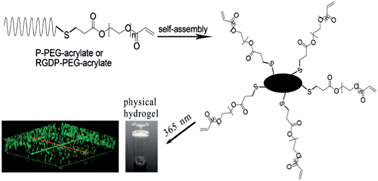Polypeptide-engineered physical hydrogels designed from the coiled-coil region of cartilage oligomeric matrix protein for three-dimensional cell culture†
Abstract
Photo-cross-linkable physical hydrogels based on the coiled-coil region of the cartilage oligomeric matrix protein and polyethylene glycol diacrylate were designed and synthesized to mimic the natural extracellular matrix for three-dimensional cell culture. The engineered polypeptides (Pcys and RGDPcys) were modified with polyethylene glycol diacrylate to form photo-cross-linkable multifunctional macromers via the Michael-type addition reaction between the cysteine residues and acrylates. Gel formation was confirmed by rheological measurements. The swelling ratio and stability of 10% w/v RGDP-PEG-acrylate6k hydrogel were 38% and 15 days, respectively. Spreading and migration of encapsulated fibroblast cells were observed in these physical hydrogels, while round cells were observed in a covalent control hydrogel. In addition, rapid self-healing of these physical hydrogels can provide a flexible way to build tissue by self-assembly and bottom-up approach. The results demonstrate that such physical hydrogels are expected to have great potential applications in tissue engineering.


 Please wait while we load your content...
Please wait while we load your content...